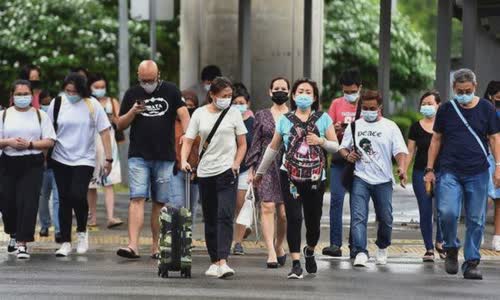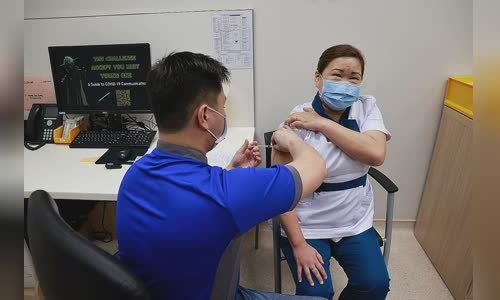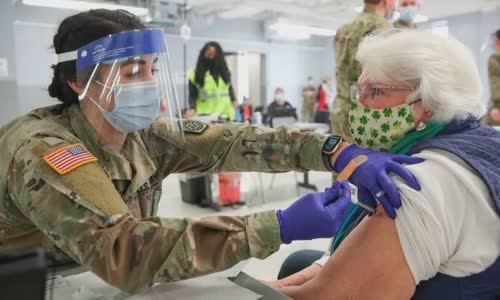Some countries bring NCOV infected people slightly and not symptoms into concentrated medical facility, but many places for home treatment to reduce social pressure.
Singapore still applies concentration measures to NCOV infected people, though patients do not have symptoms of symptoms or mild disease.

Photo: Reuters.
According to Dr. Satya P.K.
After 7 days, if the treatment facility confirms symptoms at a mild level, or clinical health stable after treatment but still positive for NCOV, the patient will be discharged and transferred to a care facility
Unlike serious cases, Covid-19 mild symptoms do not need to intervene in addition to oxygen or treatment.
Singaporeans are required to wear a mask when going to the road during the outbreak of community infection in May. Photo: Reuters.
Most NCOV infections in Singapore have mild or asymptomatic symptoms.
As of June 30, the island is still 133 cases being monitored in the hospital.
With the progress of the Covid-19 vaccination program in Singapore, the island is divided into a strategy to live with the pandemic.
According to the Biological Statistics Researcher Alex Cook and the infectious disease expert HSU Li Yang of the Saw Swee Hock Community Health School of Singapore National University, the treatment of Covid-19 patients without distinguishing the level
Although the old strategy proves the effectiveness of the epidemic situation, maintaining it for a long time will create fatigue for society.

Photo: Straits Times
According to experts, the method of separation of all cases in the hospital or community care facility will no longer be necessary once the majority of people have been protected by vaccine.
Singapore organizes vaccination for medical staff in January. Photo: Straits Times
Quick response to control spreads with key meanings.
The Statistics of Singgapore's Ministry of Health in the last 28 days of domestic cases showed that 1% of Covid-19 patients were injected with two vaccine nose, needed to intervene in oxygen during treatment.
For the group injecting a vaccine before infection of NCOV, the proportion of slight and non-symptoms was 92.9%, while 4.8% needed to support oxygen breathing and 2.4% need ICU intervention.
The decision to quit isolation and treatment at the hospital for mild or non-symptoms to require a responsible patient, self-isolation at home and resting, ensuring no infection for others, two great experts
Self-treatment plans at home for people with mild or non-symptomatic infected people have also been applied in many countries around the world.
As recommended by the American Disease Control and Prevention Center (CDC), people infected with mild NCOV should stay home unless they need medical care.
Emergency signals for Covid-19 patients needed to be hospitalized in the US include: Difficulty breathing, pain or persistent chest, loss of awake or skin, lips, the skin around the nails becomes pale pale.

Photo: AFP.
People in the same family need to limit maximum contact with NCOV infected people, do not use objects, clean hygiene and disinfect regular common spaces, and arrange separate toilets for infected people if any
Country guards support a vaccine point in Illinois in April 2021.
In the UK, the National Health Service Agency (NHS) notes that mild Covid-19 cases do not need to be hospitalized, but still register for online health checks.
The infected person can contact the hotline to apply for advice and support interventions if the signs appear: cannot respond to the symptoms at home, the symptoms are worse, without any fever and
In addition to the above emergencies, the British medical agency only recommends that NCOV infected people bring mild symptoms to treat and isolated at home.
The process of self-isolation and treatment can last longer than a week, until people are infected with health.
Measures for people infected with NCOV mighty self-isolation and treatment are also applied in India, especially in the second wave of wave of the water system overloaded.
The relative living with the house is required to be 14-21 days and is responsible for keeping communicating with a medical facility.
However, similar to the current controversy in Singapore, the self-treatment of mild symptoms at home demanding the patient has a high self-awareness in the observance of self-isolation regulations.
Many cases of cases of non-integrated infections were recorded in India in the stage of the outbreak, causing the government in a number of localities to apply attached to curfew or distance ways of socially



 Hamaccount Zahir
Hamaccount Zahir







